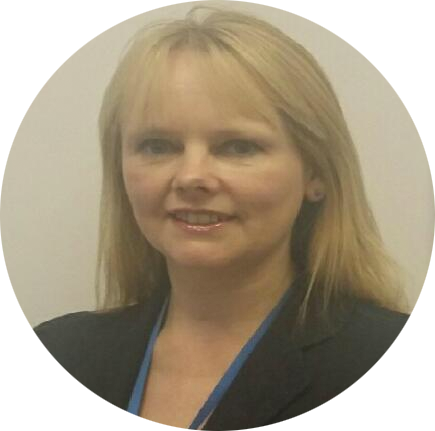Clinician of the Month – Sara Nelson, Lead Nurse for Digital, GSTT
Posted on

Our Clinician of the Month for November is Sara Nelson. As Lead Nurse for Digital at Guys & St Thomas’ NHS Foundation Trust, Sara brings an interesting dimension to the need for cultural change when it comes to digital transformation in the NHS. A lot of Sara’s work centres on ‘bridging the gap’ between the different agencies required to deploy a successful digital project in a large NHS trust, ensuring that clinical teams, technical teams, patients, senior management and operational staff speak (at least enough of) the same language to be able to understand one another throughout the lifecycle of a development project. Also acting acting as a central knowledge hub for digital projects across the trust, Sara and her team act as a place where clinicians keen to implement new technologies can turn for advice and validation on their ideas.
We interviewed Sara to understand some more about her role, and what we can learn from the approach.
Lead Nurse for Digital is an interesting job title, can you tell me a little more about it?
We have a Chief Clinical Information Officer (CCIO) and a Chief Nursing Information Officer (CNIO) within Guys & St Thomas’, there aren’t many CNIOs across the country so we’re quite lucky in that respect. But there became a realisation over the last few years that actually, if we want to take the strategy forward and if we want to go and be more dynamic with digital, we need more bodies to be able to do that.
And so where the CCIOs/CNIOs are strategic and will work with the senior management teams, my level is about actually having staff who are able to work at an operational level, with the clinical and the technical teams, whilst still engaging with senior management. It’s about bringing it all together.
It sounds like a really innovative position. Do you know any other trusts doing similar things?
I haven’t heard of anywhere else doing it. But a lot of the outcome from the Watcher Review will likely see trust executive boards taking a bigger role in reviewing how they actually get the dual IT and clinically trained staff, who are then able to move the digital agenda forwards. There’s a growing emphasis on encouraging newly qualified clinicians to work in the digital services.
We know that there is sometimes an issue with getting enthusiasm for new technologies to move down through different tiers of staff across the NHS. What are your thoughts on that?
The challenge is that clinical teams need to work digital innovation into the priorities of what they have on at that moment. Their priority is always going to be their patients and so they need to be able to understand how technology will work with what they’re doing to enhance the care of their patients, rather than just being an addition to the workload.
Positively, I am starting to see a sea change in this. Traditionally, IT has been put to clinicians to take on board and they’re told to input data; they don’t get to see why doing so makes a difference. But as the technology is getting more developed, it’s increasingly possible to get the data back out that helps to answer, for example, CQUINS, or pressing questions around how you are managing your team and balancing resources. Once it becomes important to the level of staff who do this day in day out, and teams can see the benefit for themselves, then it starts to mean something to clinicians on the ground.
How does your role help here?
It’s all about communication. I have the initial trust with the clinical teams that comes from having worked in the environment for many years, but I can also have the right conversations with the technical teams, which I can then bring back to the clinical teams in a way which allows them to understand what the impact is going to be for them.
Sometimes the jargon coming out of each of these teams can mean that communication doesn’t get across sufficiently. So allowing somebody to be that middle man between the two, allows concerns to be expressed by either side, and and actually highlighted to the other side in a way that they understand.
It’s about bridging the gap! Can you tell us a little more about what you’ve been doing since you started?
I’ve been doing the role for 12 months now. A lot of that time has been taken up in meeting the varied members of the teams and seeing what the different teams want from each other, and actually working out what the priorities are. A lot of time has been spent networking, and allowing the teams to understand each other, and making introductions. We’ve also been establishing some ground rules so that people can start to understand and access each other, and we can get staff engaged with this.
There’s so many enthusiastic colleagues who want to go off and do great things. The benefit of being a visible clinician is that staff can come to us wanting to bring this into their environment, and we can say ‘oh there’s a similar environment just down the road that would benefit from this as well – perhaps if you look at this together you may be able to move forward quicker, or share funding.’ Its about bringing together that knowledge from across the trust so that we know what’s happening and can share the learning from the range of projects taking place. We act as a central point from a nursing perspective where we can identify shared standards, shared documentation and develop better understanding of what might work and what might not.
It sounds like this could help with managing resources?
Obviously, we have got to look at what works within the resources that are available. But because we have the understanding of what works and what doesn’t, we can help to establish whether or not an idea for technology will make a positive impact. Take a tablet, for example. Sometimes giving a tablet might help in a particular situation, but other times the amount of data needing to be inputted is too great. It’s not that the tablet couldn’t cope, but it might not feel right when you’re working with it. The success of deployments can really rest on those those kind of things.
It’s important not to lose sight of the wood for the trees. You can have something that’s all signing all dancing, but actually you might not always need a really technical solution to a problem. I had a discussion with a ward sister recently who was keen to develop an app. We had a chat about it and identified that actually it wasn’t an app she wanted, but a place where patients could very easily access information. We already have a website that is set up and ready to do just that! If it’s just an information sharing tool that’s needed, then maybe putting resources into developing a potentially costly app isn’t the most appropriate way to go. It’s about enabling colleagues to explore what they actually want from technology before making a decision on which way to go.
Can you tell us about any specific projects that you’re working on at the moment?
We’re about to go live with the the Live Bed State project. As a clinical team we have been involved in this for the best part of a year. Before Live Bed State, patients coming through the door were logged by pen and paper. The new system digitises this process, showing admissions and bed stock, highlighting where the pinch points of pressure are, so whether that’s in A&E, or on specific wards or elsewhere.
Throughout the project we’ve had a relationship with the developers which has allowed them to continually work with us, and we have been able to get them involved with the front line where patients are coming in through the A&E. They’ve been able to have regular conversations with the site management team, bed management team and the A&E front door, and actually we’ve been able to develop a system which specifically answers their challenges, and has been designed with an understanding of how the teams work in practice.
When developers understand exactly the impact the product is going to have and how it will be used, it makes the finished tool much more user-friendly. Developers can call me and say ‘Sara, does this make sense to a nurse?’, or clinicians can phone and say ‘Sara, I’ve just looked at this – what do the developers mean by it?’ It makes the whole process much smoother, and crucially, it ensures that the stakeholders are engaged in the project all they way through. So the teams are very aware of how a product has been brought together, they know how it works, what’s gone into it and that it’s got their best interests at heart. So they feel a part of it, rather than just having been presented with a new tool and told to use it.
It sounds great. Tell us about the challenges you face in all of this.
Definitely the communication, from the point of view of language. Even if you take a single project team, the language that is spoken by IT, clinical staff, patients, is all different. We are all used to using our own colloquialisms and anachronisms, so it’s about getting used to those. It’s been an interesting obstacle, but it isn’t insurmountable.
Time is another issue. Clinical staff time is very stretched and if an email lands in an inbox, it depends on the priorities of the staff at that point as to whether something that actually doesn’t affect them at that moment will get answered. If you are expecting an answer to an email, it may not come back immediately. And if it doesn’t come back immediately it may end up being put on the back burner. That’s just the way that life is at the moment.
It’s that cultural challenge again – really it’s all about priorities.
It is, and in terms of innovators working with the NHS, it’s about understanding who are the right people to speak to. Sometimes you’ll find that it’s not always the technical teams you need to be engaging with. Chief Technology Officers (CTOs), for example, are often very full up with the technical priorities from a high level at the moment in time and sometimes, it may be better to engage through the clinical route, to actually see whether the innovation will add something of value and, if so, to get support from the clinical teams who will actually use the tech. You need your champion, and It’s important to get this validation and to understand the team you’re looking to work with. You need to really know where within the system your innovation fits. Again, that’s where roles like ours fit in. We can help signpost to appropriate areas.
Many thanks to Sara for her time.
If you’re an innovator looking to work with Guys & St Thomas’ NHS FT, Sara may be able to help. Please get in touch with DigitalHealth.London in the first instance:
info@digitalhealth.london


